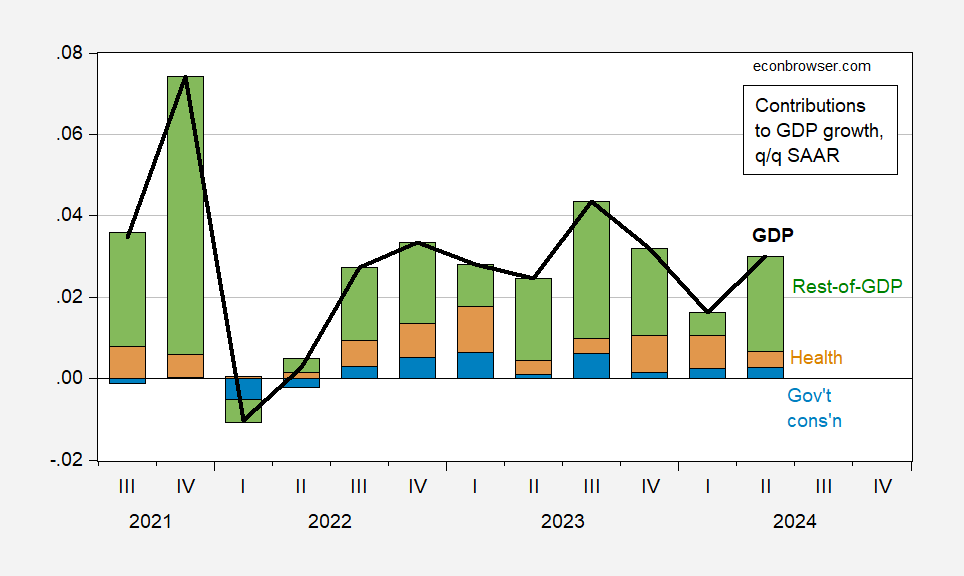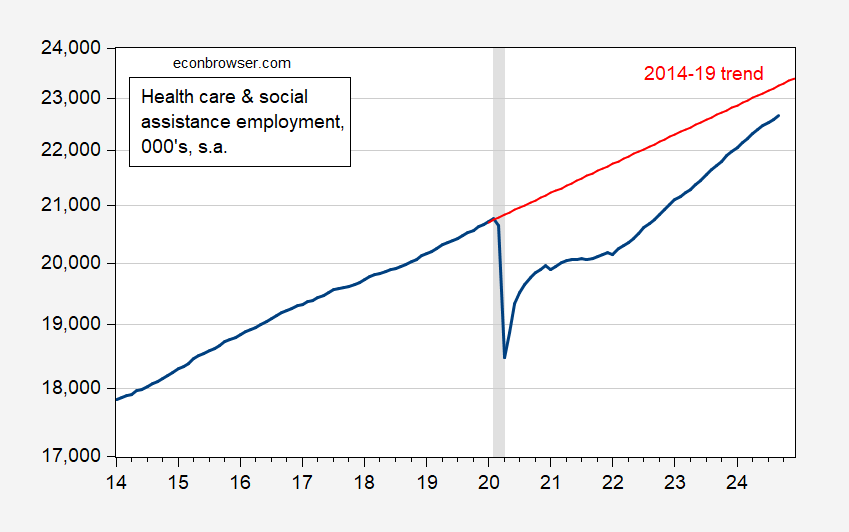A common refrain I see in some conservative circles is that employment gains or GDP are juiced by “fake” activity, of which government spending is one and health care services are another (health care services are allegedly “fake” by virtue of being mostly government funded – at least that’s the argument I see a lot).
So, here’re two pictures of GDP accounting for these arguments, and two pictures of employment (aside: if you think that heart operation you got had zero utility for you, these are the graphs for you!):
Figure 1: GDP growth q/q SAAR (black line), contribution from health care consumption (tan bar), from government consumption (blue bar), from rest-of-GDP (green bar). Source: BEA 2024Q2 release/annual update, and author’s calculations.
Figure 2: GDP growth q/q SAAR (black line), GDPNow 10/1 estimate (chartreuse box), GDP growth ex government consumption (teal), growth ex-government consumption and health care consumption (red), Source: BEA 2024Q2 release/annual update, and author’s calculations.
Hence, growth is still pretty positive since 2022Q1, regardless of whether government consumption, or health care consumption, is excluded.
What about employment? As EJ Antoni has noted, over half of y/y employment growth is accounted for by government and health care.
Figure 3: Nonfarm payroll (NFP) employment growth y/y (black line), contribution from health care and social services (tan bar), from government (blue bar), from rest-of-NFP (green bar). Source: BLS and author’s calculations.
Dr. Antoni notes:
More than half of last 12-months of job growth has come from gov’t and the gov’t-dominated healthcare sector; it’s all tax-payer funded, and it’s not at all sustainable
I’ll just point out that context is important. In addition to an aging population (ever have to deal with your parents’ health care and housing issues?), there was a big hit to the level of health care and social assistance employment during the pandemic, as shown in Figure 4.
Figure 4: Health care and social assistance employment (blue), and stochastic (log) trend estimated over 2014-19 period (red), all in 000’s, s.a. Plotted on log scale. NBER defined peak-to-trough recession dates shaded gray. Source: BLS, NBER, and author’s calculations.
Seems to me we have some catch-up to do on health care and social services employment, so maybe sustainable for some time?




Maybe need more health care employment to take care of the mentally retarded conservatives who lap up Antoni’s dishonesty,
There are 3 key economic concepts that I guess fake PhD EJ Antoni was never taught.
The first is demographics as in an aging population will require more health services. The second is income elasticity. I suspect the health care has an income elasticity greater than one. So as the population ages and income rises per capita, it is natural to think the demand for health care services would rise relative to real GDP.
And of course there is Baumol’s cost disease where the productivity of workers in service sectors does not rise as fast as the productivity of workers in good sectors. In terms of the health care sector, we see high pay for doctors as we simply have not kept up with the demand for doctors.
Now this adds to your comment about the supply of health care professionals post the pandemic:
“In addition to an aging population (ever have to deal with your parents’ health care and housing issues?), there was a big hit to the level of health care and social assistance employment during the pandemic, as shown in Figure 4.”
Simply put – we need more health care professionals not less. Since Antoni does not get this – do not hire this MAGA moron to do health care economics.
I always wonder where these people are when the GOP is in power. Are the numbers fake then?
[ Golf gallery applause ]
Off topic – forced migration and Israel’s wars:
https://theconversation.com/a-year-of-escalating-conflict-in-the-middle-east-has-ushered-in-a-new-era-of-regional-displacement-240425
Israel is currently dropping explosives in Gaza, Lebanon, Syria and Yemen, and is threatening to bomb Iran. Bombing is often in civilian areas. Israel has also invaded, or is threatening to invade – depends on who you believe – Southern Lebanon. The authors of the article speculate regarding displacement of civilians. Gazans are, of course, internally displaced because Israel won’t let them leave Gaza, even though 90% of structures have been destroyed. For now, most civilians displaced in other countries under Israeli attack are sticking close to home, but not all. With time, more will immigrate.
In Lebanon, roughly 1,000,000 civilians have already been displaced, as have 63,000 Israelis on the other side of the border. About 239,000 Lebanese and Syrian refugees in Lebanon have fled to Syria. To Syria, for crap sake!
The authors demonstrate that, for Southern Lebanese, displacement and forced immigration are well established habits. Every 15 to 20 years, Israel invaded. Civilians always suffer more than Hezbollah, just as with Gazans and Hamas.
Israel’s isn’t the only government bombing civilian areas. The U.S. just hit Sanaa, the capitol of Yemen.
Anyhow, the upshot is many more displaced people in a region already full of displaced people, governments already under strain facing greater strains.
Antoni’s use of “unsustainable” is a problem for at least three reasons. First, Antoni doesn’t show that healthcare and government employment growth are unsustainable. He merely asserts it, and we know Antoni to be a liar. Second, “unsustainable” has long been code for “We don’t want to pay for this” among dishonest conservatives. The honest statement is “this costs money”. Whether it is affordable depends on tax pocy, other spending choices and borrowing capacity.
Finally, what’s the problem with “unsustainable”? If, for instance, employment growth is partly driven by recovery from recession, that part is unsustainable, but we cheer for the recovery, for the unsustainable increment of growth. If employment growth is driven in part by an increase in labor participation among women, the part driven by increasing female participation in the workforce is unsustainable, but a good thing for women. Antoni is using “unsustainable” to imply a problem, but he has it backwards. As Figure 4 demonstrates, the increase in government and healthcare employment is evidence of a problem being solved. Antoni pretends that what is good is actually bad. More evidence that he’s a liar.
Remember Amity Shlaes? Her whole shtick was that government doesn’t count. She would at times simply forget to tell her audience that she leaves government employment and activity out when assessing the economy.
She should be calling these new guys out for stealing her idea (sic).
I’m trying to be generous as one would think Antoni has some alleged expertise. Never mind this MAGA moron sucks at health economics, has no clue when it comes to labor economics, and is otherwise incompetent beyond belief. Here is what his Heritage bio says:
‘EJ Antoni is a Research Fellow in The Heritage Foundation’s Grover M. Hermann Center for the Federal Budget.’
So they are saying he is good at public finance? Seriously? I see no evidence of that either.